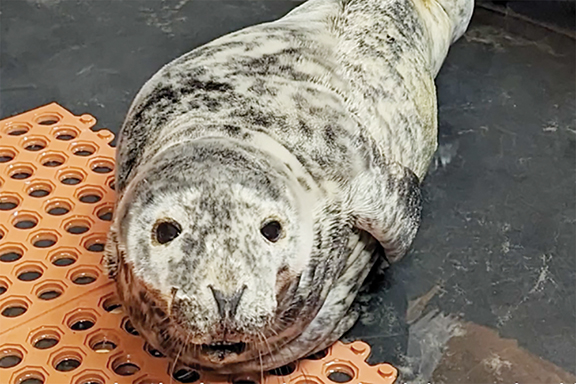‘It is very critical they get to rest undisturbed.’ – Michele Pagel, Marine Mammal Stranding Center
OCEAN CITY — Picture three school buses parked end to end: That’s how far you should stay away from seals resting on the beach because spooking them can harm or even cause their deaths.
And if you want to take pictures — from a distance — don’t post them on social media tagging their location because that may just lead to more people bothering them.
Seals are federally protected animals, according to Michele Pagel, assistant director of the Marine Mammal Stranding Center in Brigantine.
“Harassment is illegal,” she stressed.
Many people don’t realize that seals have to emerge onto land to rest.
“People think they should always be in the water. They’re physically designed to spend a lot of time in the water, hunting and diving and holding their breath for a long time, but when they do that a lot of stress is put on their body,” Pagel explained.
“When diving underwater, they’re holding their breath for 30 minutes at a time and their body is going to shunt their blood from everywhere to all their major organs. When they’re done hunting and diving, they have to come up on land to get that oxygen circulating,” she said.
“That’s why it’s so important when they’re on the beach that we don’t disturb them, scare them or chase them back into the water until they’re ready because a very tired seal or a sick seal or injured seal, if they get spooked back into the water before they’re ready, they could actually drown.
“It is very critical they get to rest undisturbed,” Pagel said.
“People should stay at least 150 feet, but further if the seal is aware of your presence. So if you’re on the beach and you back up 150 feet and the seal is still looking in your direction, or if it’s doing behavior such as waving a flipper or vocalizing, that means that seal is still aware of you and you’re too close,” she said.
She uses a trick to visualize the 150 feet “since you don’t have a tape measure on the beach.” She said to imagine three school buses lined up. That’s a good approximation for 150 feet.
And that’s the minimum distance.
The other big thing people should “never disclose the location of seals on social media.” She said people like to post pictures but if they say where they spot them, that encourages more people to seek out the seal for pictures and disturb them.
The third thing people should do if they see is seal is report it to the Stranding Center hotline at (609) 266-0538. That way they can send out a local volunteer who can help the team assess the animal to see if it is fine or if it needs help, which would prompt the center to send out a team.
Young seals are
weaned quickly
then abandoned
In New Jersey, there are three common seals, according to Pagel.
Right now the center is seeing and caring for a lot of juvenile and pup grey seals. Harbor seals also are common in New Jersey.
Harp seals are more of an arctic species that travel this far south. They have been spotted in the area this year as well.
“Very rarely” are hooded seals, another arctic variety, spotted locally. They are from even farther north and one hasn’t been see in the area since 2008.
The grey seals being spotted so frequently now are born on islands in New England and Canada. They are born only between December and February and have an “incredibly short” nursing period, she said. The mothers only nurse them for two weeks “before she abandons them.”
“She leaves the two-week-old pups on the beach and from that point on they’re independent. They’re essentially figuring out life. They’re responsible for feeding themselves and avoiding predators” while making a migration south.
A lot come into New Jersey. Others go farther into Maryland and Virginia and even into the Carolinas, she said.
The ones that can’t find their own food are the ones that strand and may end up in the care of the Stranding Center.
She said one seal stranded at the beginning of the season had been bitten by a shark. Land predators such as foxes and coyote go after them, as do some older adult seals where they breed, to get them away from the females.
“We see all kinds of injuries on these guys,” Pagel said.
The Stranding Center posts regularly on its Facebook page, including one recently called “seal of disapproval.”
“It has body language photos because people always think the seal is waving at me. That he’s my friend. That kind of stuff,” Pagel said.
Hint: they’re not being friendly.
That post includes warnings about what to watch out for when you spot a seal.
– By DAVID NAHAN/Sentinel staff
Photo of seal rescued from Fifth Street jetty in Ocean City courtesy of Marine Mammal Stranding Center.



